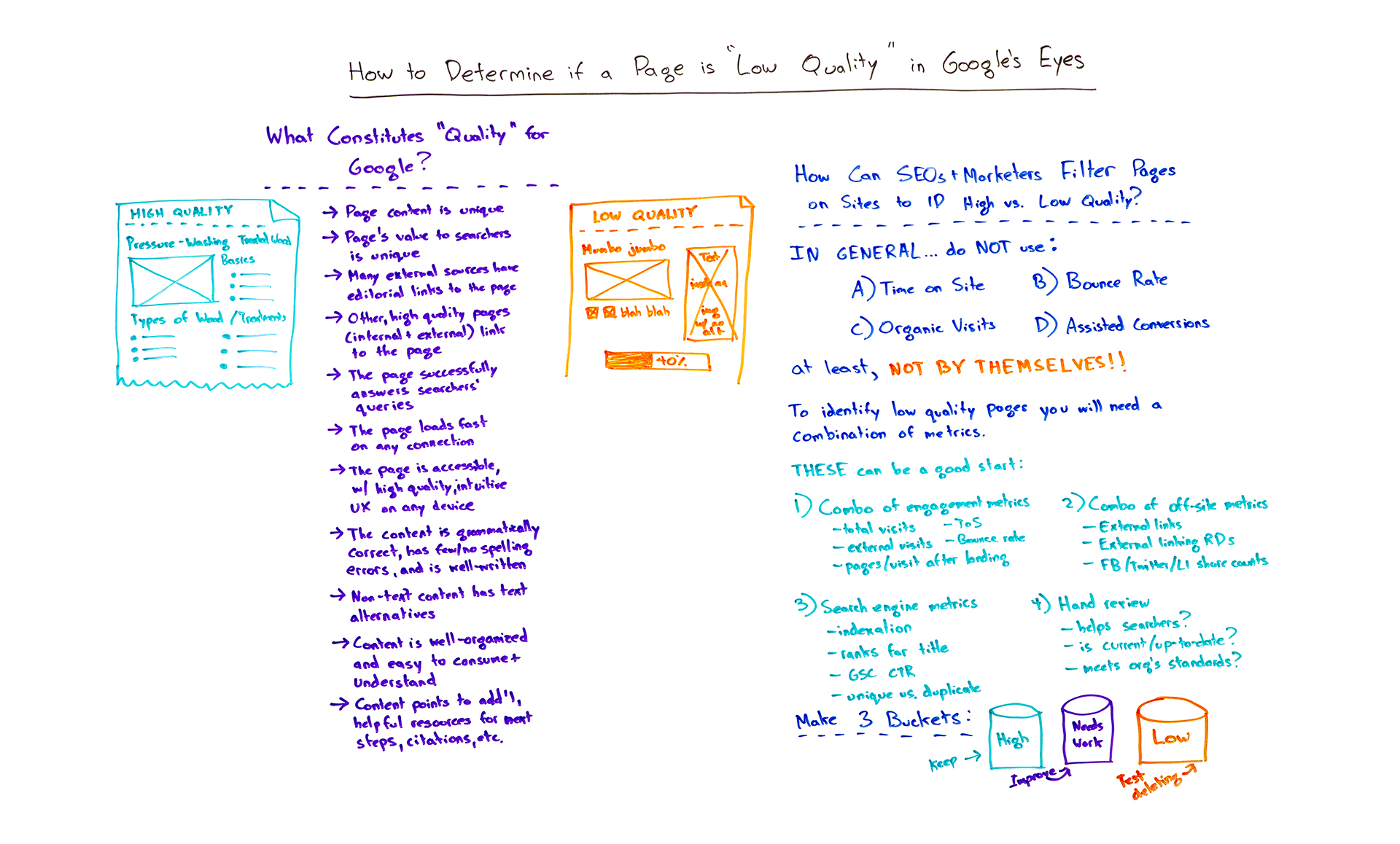Source: Moz

What are the factors Google considers when weighing whether a page is high or low quality, and how can you identify those pages yourself? There’s a laundry list of things to examine to determine which pages make the grade and which don’t, from searcher behavior to page load times to spelling mistakes. Rand covers it all in this episode of Whiteboard Friday.
.

Click on the whiteboard image above to open a high-resolution version in a new tab!
Video Transcription
Howdy, Moz fans, and welcome to another edition of Whiteboard Friday. This week we’re going to chat about how to figure out if Google thinks a page on a website is potentially low quality and if that could lead us to some optimization options.
So as we’ve talked about previously here on Whiteboard Friday, and I’m sure many of you have been following along with experiments that Britney Muller from Moz has been conducting about removing low-quality pages, you saw Roy Hinkis from SimilarWeb talk about how they had removed low-quality pages from their site and seen an increase in rankings on a bunch of stuff. So many people have been trying this tactic. The challenge is figuring out which pages are actually low quality. What does that constitute?

What constitutes “quality” for Google?
So Google has some ideas about what’s high quality versus low quality, and a few of those are pretty obvious and we’re familiar with, and some of them may be more intriguing. So…
- Google wants unique content.
- They want to make sure that the value to searchers from that content is actually unique, not that it’s just different words and phrases on the page, but the value provided is actually different. You can check out the Whiteboard Friday on unique value if you have more questions on that.
- They like to see lots of external sources linking editorially to a page. That tells them that the page is probably high quality because it’s reference-worthy.
- They also like to see high-quality pages, not just sources, domains but high-quality pages linking to this. That can be internal and external links. So it tends to be the case that if your high-quality pages on your website link to another page on your site, Google often interprets that that way.
- The page successfully answers the searcher’s query.
This is an intriguing one. So if someone performs a search, let’s say here I type in a search on Google for “pressure washing.” I’ll just write “pressure wash.” This page comes up. Someone clicks on that page, and they stay here and maybe they do go back to Google, but then they perform a completely different search, or they go to a different task, they visit a different website, they go back to their email, whatever it is. That tells Google, great, this page solved the query.

If instead someone searches for this and they go, they perform the search, they click on a link, and they get a low-quality mumbo-jumbo page and they click back and they choose a different result instead, that tells Google that page did not successfully answer that searcher’s query. If this happens a lot, Google calls this activity pogo-sticking, where you visit this one, it didn’t answer your query, so you go visit another one that does. It’s very likely that this result will be moved down and be perceived as low quality in Google.
- The page has got to load fast on any connection.
- They want to see high-quality accessibility with intuitive user experience and design on any device, so mobile, desktop, tablet, laptop.
- They want to see actually grammatically correct and well-spelled content. I know this may come as a surprise, but we’ve actually done some tests and seen that by having poor spelling or bad grammar, we can get featured snippets removed from Google. So you can have a featured snippet, it’s doing great in the SERPs, you change something in there, you mess it up, and Google says, “Wait, no, that no longer qualifies. You are no longer a high-quality answer.” So that tells us that they are analyzing pages for that type of information.
- Non-text content needs to have text alternatives. This is why Google encourages use of the alt attribute. This is why on videos they like transcripts. Here on Whiteboard Friday, as I’m speaking, there’s a transcript down below this video that you can read and get all the content without having to listen to me if you don’t want to or if you don’t have the ability to for whatever technical or accessibility, handicapped reasons.
- They also like to see content that is well-organized and easy to consume and understand. They interpret that through a bunch of different things, but some of their machine learning systems can certainly pick that up.
- Then they like to…
Peter Bordes Jr
Founder & Managing Partner Trajectory Ventures. Lifetime entrepreneur, CEO, Board Member, mentor, advisor and investor.
Obsessed with the infinite realm of possibility in disruptive innovation driving global digital transformation in technology, cloud-based infrastructure, artificial intelligence, data, DevOps, fintech, robotics, aerospace, blockchain and digital media and advertising.

